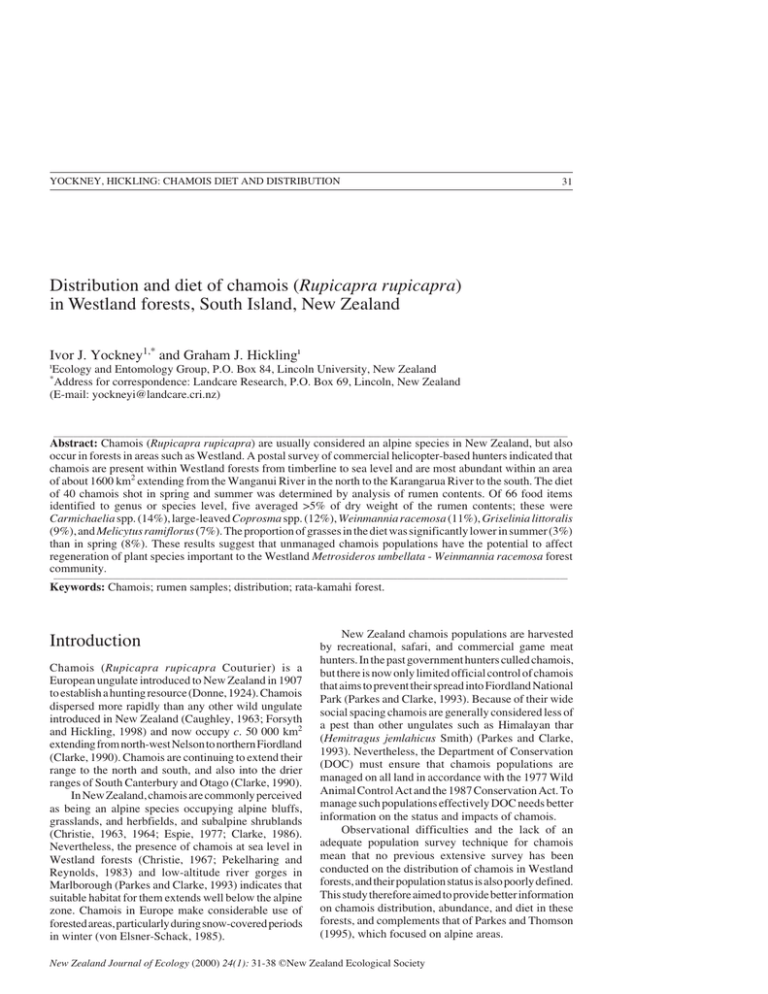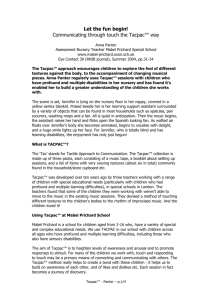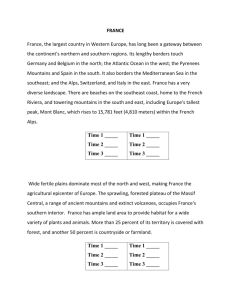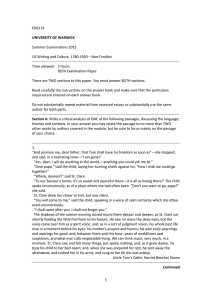Rupicapra rupicapra in Westland forests, South Island, New Zealand Ivor J. Yockney
advertisement

YOCKNEY, HICKLING: CHAMOIS DIET AND DISTRIBUTION 31 Distribution and diet of chamois (Rupicapra rupicapra) in Westland forests, South Island, New Zealand Ivor J. Yockney1,* and Graham J. Hicklingı ı Ecology and Entomology Group, P.O. Box 84, Lincoln University, New Zealand Address for correspondence: Landcare Research, P.O. Box 69, Lincoln, New Zealand (E-mail: yockneyi@landcare.cri.nz) * __________________________________________________________________________________________________________________________________ Abstract: Chamois (Rupicapra rupicapra) are usually considered an alpine species in New Zealand, but also occur in forests in areas such as Westland. A postal survey of commercial helicopter-based hunters indicated that chamois are present within Westland forests from timberline to sea level and are most abundant within an area of about 1600 km2 extending from the Wanganui River in the north to the Karangarua River to the south. The diet of 40 chamois shot in spring and summer was determined by analysis of rumen contents. Of 66 food items identified to genus or species level, five averaged >5% of dry weight of the rumen contents; these were Carmichaelia spp. (14%), large-leaved Coprosma spp. (12%), Weinmannia racemosa (11%), Griselinia littoralis (9%), and Melicytus ramiflorus (7%). The proportion of grasses in the diet was significantly lower in summer (3%) than in spring (8%). These results suggest that unmanaged chamois populations have the potential to affect regeneration of plant species important to the Westland Metrosideros umbellata - Weinmannia racemosa forest community. __________________________________________________________________________________________________________________________________ Keywords: Chamois; rumen samples; distribution; rata-kamahi forest. Introduction Chamois (Rupicapra rupicapra Couturier) is a European ungulate introduced to New Zealand in 1907 to establish a hunting resource (Donne, 1924). Chamois dispersed more rapidly than any other wild ungulate introduced in New Zealand (Caughley, 1963; Forsyth and Hickling, 1998) and now occupy c. 50 000 km2 extending from north-west Nelson to northern Fiordland (Clarke, 1990). Chamois are continuing to extend their range to the north and south, and also into the drier ranges of South Canterbury and Otago (Clarke, 1990). In New Zealand, chamois are commonly perceived as being an alpine species occupying alpine bluffs, grasslands, and herbfields, and subalpine shrublands (Christie, 1963, 1964; Espie, 1977; Clarke, 1986). Nevertheless, the presence of chamois at sea level in Westland forests (Christie, 1967; Pekelharing and Reynolds, 1983) and low-altitude river gorges in Marlborough (Parkes and Clarke, 1993) indicates that suitable habitat for them extends well below the alpine zone. Chamois in Europe make considerable use of forested areas, particularly during snow-covered periods in winter (von Elsner-Schack, 1985). New Zealand chamois populations are harvested by recreational, safari, and commercial game meat hunters. In the past government hunters culled chamois, but there is now only limited official control of chamois that aims to prevent their spread into Fiordland National Park (Parkes and Clarke, 1993). Because of their wide social spacing chamois are generally considered less of a pest than other ungulates such as Himalayan thar (Hemitragus jemlahicus Smith) (Parkes and Clarke, 1993). Nevertheless, the Department of Conservation (DOC) must ensure that chamois populations are managed on all land in accordance with the 1977 Wild Animal Control Act and the 1987 Conservation Act. To manage such populations effectively DOC needs better information on the status and impacts of chamois. Observational difficulties and the lack of an adequate population survey technique for chamois mean that no previous extensive survey has been conducted on the distribution of chamois in Westland forests, and their population status is also poorly defined. This study therefore aimed to provide better information on chamois distribution, abundance, and diet in these forests, and complements that of Parkes and Thomson (1995), which focused on alpine areas. New Zealand Journal of Ecology (2000) 24(1): 31-38 ©New Zealand Ecological Society 32 NEW ZEALAND JOURNAL OF ECOLOGY, VOL. 24, NO. 1, 2000 Methods Study area Chamois distribution and density were assessed in forested areas west of the Main Divide of the Southern Alps between the Taramakau River to the north and the Arawata River to the south (Fig. 1). Preliminary investigations indicated that chamois are less common in forested areas outside the Taramakau-Haast area, so it was decided to confine the study to within these geographic boundaries. Annual rainfall in the study area is high, increasing from 3000 mm at sea level to 11 000 mm or more near the Main Divide (Potton, 1985). The winter snowline is typically 1200-1500 m a.s.l., retreating to 2100-2400 m above sea level in late summer (Potton, 1985). Temperatures at lower altitudes are influenced by the moderating coastal climate, with maximum summer air temperatures within Westland National Park averaging 20°C (Reif and Allen, 1988). Podocarp-broadleaved forests dominate much of central Westland. Beech species (Nothofagus spp.)1 are absent between 42E 50' S and 43E 40' S (Reif and Allen, 1988) but become abundant south of the Karangarua River. With increasing elevation, a change from podocarp to rata (Metrosideros umbellata) forest occurs. Subalpine shrubs consisting of mainly Dracophyllum spp. (Wardle, et al., 1973) occur in a belt above the tree line (c.1000 m); tussock and herbfields predominate above about 1200 m (Wardle, 1975). Chamois distribution and abundance Chamois distribution was mapped using information gathered from a postal survey of 12 helicopter pilots who held Wild Animal Control permits within the study area during 1995 -1996. The survey form provided a list of (n = 69) major catchments (ranging from 1700 34000 ha) within the study area, and the respondents were asked to: (1) state whether female chamois were present or absent in each catchment (the presence of female chamois gives a more accurate measure of breeding range since male chamois are known to move considerable distances from breeding populations; Clarke, 1986); and (2) categorise the abundance of female and juvenile chamois in each catchment, using the following four abundance categories derived from a previous study of chamois in the eastern Southern Alps (Clarke and Frampton, 1991): High = females and juveniles typically seen in groups of >5; ______________________________________________________________ 1 Botanical nomenclature follows Allan (1982) and Connor and Edgar (1987). Medium = females and juveniles typically seen in groups of 2-4; Low = females typically seen in groups of 2; and Absent = female chamois never seen. Space was provided for respondents to add any other information that they considered relevant. All 12 operators agreed to participate in the study, but only eight responded. Their information on chamois distribution and abundance for each of the n = 69 catchments was then mapped, each catchment coloured according to its abundance level. Two local hunters who had extensive knowledge of the study area were asked to critique the resulting draft map and this resulted in only minor adjustments. Diet Rumen samples were obtained from chamois shot in a 45-km2 area within the Whataroa catchment in 1995-96 (Fig. 1). Chamois were known to be common in this catchment (I. Yockney, pers. obs.), which is typical in geology, climate, and vegetation of the large valleys of central Westland. Chamois were ground-hunted in the morning and evenings, generally along creekbeds, slips, and river terraces. When groups were encountered, the mature animals were preferentially shot. All samples came from the rata-kamahi (Metrosideros umbellata Weinmannia racemosa) forest type, which dominated the catchment. The sampling period was divided into spring (October-December) and summer (JanuaryFebruary). The contents of each rumen was thoroughly mixed and c.1 litre of contents was stored in a plastic bag with 200 ml of FAA preservative (10% formalin, 49% absolute ethanol, 2% acetic acid, 39% water), and labelled with date, age (estimated from tooth eruption), sex, area, and location. These samples were analysed using the macroscopic sorting technique described in Nugent (1983). Briefly, 200 ml of the sample was washed through a 4-mm sieve, and fragments from a 10-g sub-sample were identified using a 5x monocular microscope and a reference collection of plant material. Unidentifiable fragments were labelled as such; any identifiable vegetation types that could not be distinguished to genus level were labelled as unidentified grass, unidentified woody stem, etc. Sub-samples were then dried at 70°C for 24 h, and then weighed to the nearest 0.001g. Dry weights were converted to a percentage of the total rumen sample. The percentage of each plant species (and when unknown, food class) per rumen was transformed using ln (x + 1) to normalise the variance structure. Analysis of variance was used to determine if any significant differences in diet occurred in relation to age, sex, or season. Frequency of occurrence was calculated by presence or absence of each species in the samples (±95% C.I). YOCKNEY, HICKLING: CHAMOIS DIET AND DISTRIBUTION 33 Figure 1. Distribution and abundance of chamois in Westland forest catchments between the Taramakau and Arawata rivers. Unshaded areas west of the Southern Alps represent areas in which breeding populations of chamois were reported absent. The box located over the headwaters of the Whataroa River indicates the approximate area (c.45 km2) in which chamois rumen samples were collected. 34 NEW ZEALAND JOURNAL OF ECOLOGY, VOL. 24, NO. 1, 2000 Table 1. Spring and summer diet of chamois in Westland forests. Data are means of untransformed data, showing frequencies of occurrence (%) and dry weight (%) (both with ±95% CI) for species comprising >0.1% DW of rumen contents. Means for each food class are in bold _________________________________________________________________ SPECIES Frequency of occurrence Dry weight (%) ______________________________________ Mean ± 95% C.I.1 Mean ± 95% C.I. ______________________________________________________________ Woody plants Canopy trees Weinmannia racemosa Metrosideros umbellata Prumnopitys ferruginea2 Subcanopy trees Griselinia littoralis Carpodetus serratus Raukaua simplex3 Pseudopanax crassifolius Pseudopanax spp. Melicytus ramiflorus Schefflera digitata Aristotelia serrata Fuchsia excorticata 83.24 4.38 Herbaceous plants (total) Nertera ciliata Phormium cookianum Ranunculus spp. Lotus spp. Gunnera monoica Astelia spp. Unidentified herbs Lichens Unidentified lichen Fungi Moss and liverworts Total 17.5 2.5 12.5 10.0 2.5 7.5 40.0 12.3 5.1 10.7 9.7 5.1 8.5 15.9 30.0 14.8 4.29 0.32 0.18 0.19 1.16 0.13 0.15 1.89 0.28 0.28 0.03 0.11 100.00 2.72 1.85 1.13 0.87 5.45 0.82 0.60 4.83 0.23 0.73 0.07 0.06 ______________________________________________________________ 1 97.5 35.0 27.5 5.1 15.4 14.5 11.10 1.85 0.28 8.87 4.54 0.76 87.5 77.5 25.0 5.0 45.0 62.5 45.0 30.0 2.5 10.7 13.5 14.0 7.1 16.1 15.7 16.1 14.8 5.1 9.02 8.17 1.78 2.00 0.46 1.09 0.15 0.93 1.05 1.81 7.11 10.41 2.05 3.93 0.41 0.84 0.63 3.97 Shrubs Coprosma spp. (large leaved) Myrsine australis Coriaria sarmentosa Coriaria arborea Coriaria spp. Gaultheria depressa Gaultheria crassa Gaultheria rupestris Carmichaelia spp. Hebe spp. Olearia spp. Unidentified stem Unidentified leaf Unidentified fibre 97.5 15.0 7.5 7.5 15.0 7.5 27.5 10.0 77.5 17.5 5.0 97.5 52.5 65.0 5.1 11.6 8.5 8.5 11.6 8.5 14.5 9.7 13.5 12.3 7.1 5.1 16.2 15.4 11.96 10.62 0.40 1.64 0.37 1.76 0.53 2.36 1.07 4.52 0.15 0.58 0.66 1.92 0.15 0.65 14.26 21.36 0.22 0.79 0.25 1.16 9.79 6.62 0.97 2.59 5.90 8.64 Ferns and allies (total) Blechnum procerum5 Blechnum chambersii Blechnum spp. Phymatosorus pustulatus4 Asplenium flaccidum Asplenium bulbiferum Hymenophyllum dilatatum Hymenophyllum spp. 72.5 7.5 30.0 67.5 35.0 57.5 2.5 32.5 14.5 8.5 14.8 15.2 15.4 16.0 5.1 15.2 4.35 1.08 0.11 0.84 0.72 0.18 0.91 0.11 0.14 1.66 2.40 0.40 3.35 1.03 0.41 1.96 0.69 0.35 Grasses and sedges (total) Chionochloa spp. 10.0 Unidentified grasses 95.0 9.7 7.1 7.70 0.21 7.45 2.80 1.35 8.80 ______________________________________________________________ Confidence Interval Recent taxonomic changes follow: 2Connor and Edgar (1987), 3 Mitchell et al., (1997) and 4Large et al., (1992). 5 Blechnum procerum comprises B. procerum, B. novaezelandiae, B. montanum and B. triangularifolium (Chambers and Farrant, 1998). Results Distribution and abundance The eight respondents were in close agreement in their classification of chamois distribution and abundance for each catchment. There were only two inconsistencies in the initial reports: these were for catchments near Haast where chamois population size seems to fluctuate dramatically depending upon commercial harvest (J. Scott, helicopter pilot, Karangarua, N.Z, pers. comm.). The distribution of chamois in Westland forest shows a well-defined area of high chamois abundance between the Wanganui and the Karangarua rivers (Fig.1). This area is surrounded by medium and low populations, with several isolated medium-abundance populations near the coast at Fox Hills. Diet In 1995-96 a total of 16 and 15 rumen samples were collected during the spring and summer seasons respectively. A further 9 samples taken from within the Whataroa catchment were provided by J. Parkes (Landcare Research, Lincoln, N.Z.), which gave a sample size of 20 rumens for each season. From these, a total of 79 food items were identified to the level of species (41), genus (25), or unidentified vegetation types (13). The 45 food items that comprised more than 0.1% dry weight (DW) of spring and summer diet are listed in Table 1. Seven broad food classes were characterised. Woody plants comprised 83.2% of the dry weight YOCKNEY, HICKLING: CHAMOIS DIET AND DISTRIBUTION contents, of which shrubs and three unidentifiable woody foods comprised the greatest proportion (46.7; SE = 5.02%). The five most common identifiable species were the shrubs Carmichaelia spp., large leaved Coprosma spp., and the trees Weinmannia racemosa, Griselinia littoralis, and Melicytus ramiflorus, which together comprised more than 50% of the total diet. Coprosma spp. and W. racemosa occurred in nearly all rumens (98 ; SE = 5%) whereas Carmichaelia spp. occurred in 78% (SE = 13%) of samples. When Carmichaelia spp. were found in samples they usually occurred in large quantities. The next most commonly occurring identifiable foods were grass (95; SE = 7%) and Griselinia littoralis (88; SE = 11%). Sixteen food items comprised >1% dry weight. These included two canopy trees, five subcanopy trees, four shrubs, a fern, unidentified grasses, two herbaceous plants, and unidentifiable fibre. Differences in diet according to age, sex, and season were noted as follows. Subadult chamois ate significantly more Carpodetus serratus in spring than adult chamois but adults ate significantly more in summer than did subadults (F 1,33 = 5.44, P = 0.026 for age-season interaction). Females and males did not differ in their consumption of Blechnum chambersii in spring but males ate more in summer (F 1,33 = 4.66, P = 0.016). More Coriaria sarmentosa was eaten in spring than in summer (F 1,33 = 5.16, P = 0.030). Females ate more unidentified fungi than did males (F 1,33 = 5.67, P = 0.023), and adults consumed more unidentifiable stems than did juveniles (F 1,33 = 7.93, P = 0.008). Grass formed a higher proportion of rumen contents in spring (8%) than in summer (3%) (F 1,33 = 8.04, P = 0.008) and males ate more lichen than did females (F 1,33 = 6.04, P = 0.019). No significant trends were evident for species and food classes comprising <0.1% dry weight. Discussion Distribution and abundance The survey and mapping work reported here is qualitative but very consistent among respondents, showing that chamois have become well established in the forests of central Westland. Various factors may have contributed to this. The rocky nature of forests in this area and the ample food provided by the ratakamahi forest are both likely to suit chamois. Furthermore, the area of highest chamois numbers corresponds to an area within which red deer (Cervus elaphus L.) are at lower densities than are found in adjacent forests to the north and south (J. Mead, Department of Conservation, Franz Josef, N.Z., pers. comm.). In the Waimakariri catchment (Canterbury) 35 Fokerd (1962) observed an increase in chamois following intensive control of red deer, which suggests that red deer (and perhaps feral goats (Capra hircus L.)) will tend to exclude chamois from favoured habitats. Similarly, chamois are known to avoid thar (Forsyth, 1997), and in the parts of Westland where the two species co-occur chamois are typically seen to avoid favoured thar habitat (J. Mead, pers. comm.; J. Scott, pers. comm.). Some chamois move seasonally between the forest and alpine zones in New Zealand, and this is typical behaviour for chamois found in European forests (von Elsner-Shack, 1985). For example, in the HarperAvoca catchment (Canterbury) use of alpine bluffs and grasslands by chamois peaks in late summer and declines in winter, when snow covers much of those habitats (Clarke, 1986). During winter, chamois make use of snow-free shrubland bluffs and “denser, taller, shrubland stands” (Christie and Andrews, 1965; Clarke, 1986); these habitats will provide food and shelter during inclement weather. Some chamois in Westland will be using the forests in a similar seasonal manner, but many others almost certainly live year-round in the forests. Chamois, including groups of females with kids, are regularly seen at all times of the year in these forests (I. Yockney, pers. obs.). Some alpine chamois may use the upper forest as a temporary refuge from aerial hunting; Clarke (1990) describes chamois running for the forest in the HarperAvoca catchment at the sound of an approaching helicopter. Nevertheless, chamois were present at sea level in Westland forests long before helicopter-hunting began (Christie, 1967) so we consider the habitat factors discussed above to be more significant than hunting pressure in explaining their low-altitude distribution. The breeding range of chamois within forests extends beyond the northern boundary of our study. Helicopter pilots have reported chamois to be in moderate numbers through the Buller Gorge, and through most forested areas of those catchments where chamois are common above the shrubline (S. Lawn, helicopter pilot, Ahaura, N.Z. pers. comm.). Furthermore, sightings of chamois in areas such as Okarito, Rotokino, Bruce Bay, Lake Paringa, and Big Bay (J. Mead, pers. comm.) suggest that at least some individuals have spread well beyond the main breeding range. Clarke (1990) suggested that these movements of chamois far outside their current breeding range could see progressive colonisation of intervening areas if no management actions are taken. Diet This study of chamois diet in two seasons has provided insight into which plant species chamois eat within 36 NEW ZEALAND JOURNAL OF ECOLOGY, VOL. 24, NO. 1, 2000 Westland forests. We caution that these results cannot be interpreted in terms of dietary preferences because rumen content composition will, in part, reflect the local availability of plant species (Nugent and Challies, 1988). Data reported here, combined with general observations, suggest that chamois in New Zealand do feed somewhat selectively in that only a few species made up the bulk of the diet (cf. Christie, 1963, 1964). Hudson and White (1985) suggest that chamois are no more or less specialised feeders than other ungulate species successfully introduced into New Zealand. Comparison with diet studies on white-tailed deer (Odocoileus virginianus Miller) (e.g., Nugent and Challies, 1988) and chamois (Parkes and Thomson, 1995) tend to support this conclusion. The most comprehensive study of chamois diet in New Zealand found no significant dietary differences within and outside of thar range, or between the sexes, although seasonal differences in diet were apparent (Parkes and Thomson, 1995). For an alpine population east of the Main Divide, more woody plants and less grass and herbs were consumed in winter/spring than in other seasons (Parkes and Thomson, 1995). Significant differences in chamois diet were also found between the eastern and western populations, with Westland alpine chamois eating “more woody plants, particularly forest species and Carmichaelia, and less grasses than eastern chamois” (Parkes and Thomson, 1995). Species typically consumed in these alpine environments included Carmichaelia spp., Gaultheria crassa, Hebe spp., Coprosma serrulata, Astelia spp., Celmisia spp., Ranunculus lyallii, Epilobium spp., and Poa/ Rytidosperma spp. (Parkes and Thomson, 1995). The dependence of Westland forest chamois on woody plants, such as Carmichaelia spp., Coprosma spp., Griselinia littoralis, Weinmannia racemosa and other subcanopy hardwoods and shrubs, is consistent with diet studies of feral goats from lowland rimu (Dacrydium cupressinum) - rata - kamahi forests of eastern Mount Taranaki (Mitchell, et al., 1987), Stewart Island white-tailed deer (Nugent and Challies, 1988) and Pureora forest red deer diet (Nugent, et al., 1997). However, herbaceous plants were used more by Westland chamois (4.3%) than by white-tailed deer (1.2%) (Nugent and Challies, 1988) or red deer (0.24%) (Nugent et al. 1997). Chamois ate three times more Weinmannia racemosa (11%) than white-tailed deer (3.3%), nearly twice that of red deer (6.3%), and more than the annual mean of feral goats (9.4%). However, these comparisons must be interpreted with caution because although a common plant in all the above study areas, we have no measure of its relative abundance or availability to the animals. In our study, the only major food type that showed a significant spring-summer change in use was grass, which was favoured in spring. A possible explanation for the shift in grass intake during spring is because protein levels in grasses tend to be highest during early growth and decline as the grass matures (Robbins, 1983). Management implications In Westland, large areas of forest are dominated by a canopy of rata and kamahi and DOC implements possum control in various areas of Westland with the aim of preserving this forest structure. However, if conservation of forest structure processes and regeneration patterns are important, then it may well be that chamois and other sympatric ungulates are “worse” pests than possums. Parkes (1994) has argued that “there is little point in controlling possums in the absence of ungulate control, but there can be benefits in controlling ungulates in the absence of possum control”. The canopy of kamahi is eaten by possums (Fitzgerald and Wardle, 1979), but it is the ungulates that are most likely to inhibit the terrestrial regeneration of its seedlings (Parkes, 1994). For example, exclosure studies in the central North Island (Nugent et al., 1997) found that tall kamahi seedlings were found only where deer numbers were low, regardless of possum density, and that kamahi was the tree species most likely to respond to moderate reductions in deer density. In Westland, the areas of possum-damaged rata-kamahi forest where partial canopy recovery has been documented coincide with the “only area where browsing pressure from ungulates in the understorey tiers has been low or absent” (Pekelharing and Reynolds, 1983). These areas are now well colonised by chamois, which are likely to be replacing the effects of deer where the latter are scarce or absent (e.g., the upper montane forest and subalpine scrub). Preservation of kamahi as a canopy species is a conservation goal in Westland, and considerable effort is currently expended controlling possums to achieve this goal. Chamois in this study consumed large quantities of kamahi, so our results imply that chamois have the potential to affect the regeneration of this species. Although related in part to the high abundance of kamahi in our study area (I. Yockney, pers. obs.), kamahi was found in larger quantities in chamois diet than in the deer (Nugent and Challies, 1988; Nugent et al., 1997) and feral goat (Mitchell et al., 1987) studies mentioned above. Furthermore, use of kamahi by red deer is lowest in spring and summer (Nugent et al., 1997) and there is a similar decrease in the use of kamahi in spring by feral goats (Mitchell et al., 1987). We therefore predict that our spring-summer estimates of kamahi use by chamois is likely to underestimate the use of this species by chamois in autumn and winter. YOCKNEY, HICKLING: CHAMOIS DIET AND DISTRIBUTION The Department of Conservation conducts mammalian pest control in several areas where chamois are present. In these areas, a few chamois are shot whilst targeting other pest species such as goats in Marlborough (Parkes and Clarke, 1993). Control of chamois and deer in Westland thus relies heavily on the commercial and recreational harvest (Parkes and Clarke, 1993). Nugent et al. (1997) suggested that kamahi in the central North Island could be preserved by controlling ungulates to moderate densities using available techniques (e.g., ground-based and aerial hunting). The relationship between ungulate densities and their impacts in forests is unknown, and the benefits for these forests of ground-based and aerial hunting of chamois are consequently uncertain. Nevertheless, commercial operators take very few chamois from forests compared to the alpine habitats (J. Scott, pers. comm.), so it would seem prudent for managers to encourage recreational hunting of chamois in forest areas, at least until chamois impacts in this habitat are better understood. Our results thus highlight the need for a better understanding of ungulate-vegetation dynamics in New Zealand forests. Acknowledgements We thank Dave Forsyth for helping develop this research topic and making constructive comments on the draft manuscript. Morgan Coleman (Landcare Research) contributed many hours helping with rumen samples in the laboratory. John Parkes (Landcare Research) provided nine of the rumen samples and advice on the draft manuscript. John Mead and Terry Farrell (Department of Conservation) produced draft maps and gave much advice. Chris Frampton provided helpful statistical advice. I thank the volunteers who helped shoot chamois and provided good company on those West Coast rainy days, in particular Charles Menzies and James Lennon. Thanks also to James Scott for helicopter flights and advice on distribution data, and to all the pilots that returned surveys and provided information about chamois abundance. The project was funded by the Ecology and Entomology Group, Lincoln University. References Allan, H.H. 1982. Flora of New Zealand, Volume I. Government Printer, Wellington, N.Z. Caughley, G. 1963. Dispersal rates of several ungulates introduced into New Zealand. Nature 200: 280281. Chambers, T.C.; Farrant, P.A. 1998. The Blechnum procerum (“capense”) (Blechnaceae) complex in 37 New Zealand. New Zealand Journal of Botany 36: 1-19. Christie, A.H.C. 1963. The ecology of the chamois (Rupicapra rupicapra L.) in an alpine basin in southern Nelson. M.Sc. Thesis, Victoria University, Wellington, N.Z. Christie, A.H.C. 1964. A note on the chamois in New Zealand. Proceedings of the New Zealand Ecological Society 11: 32-36. Christie, A.H.C. 1967. The sensitivity of chamois and red deer to temperature fluctuations. Proceedings of the New Zealand Ecological Society 14: 34-39. Christie, A.H.C.; Andrews, J.R.H. 1965. Introduced ungulates in New Zealand. (C) Chamois. Tuatara 13: 105-111. Clarke, C.M.H. 1986. Chamois movements and habitat use in the Avoca River area, Canterbury, New Zealand. New Zealand Journal of Zoology 13: 175-198. Clarke, C.M.H. 1990. Chamois. In: King, C.M. (Editor), The handbook of New Zealand mammals, pp. 380391. Oxford University Press, Auckland, N.Z. Clarke, C.M.H.; Frampton, C. M. 1991. Structural changes in an apparently stable chamois population in Basin Creek, Canterbury, New Zealand. New Zealand Journal of Zoology 18: 233 -241. Connor, H.E.; Edgar, E. 1987: Name changes in the indigenous New Zealand flora, 1960-1986 and nomina nova IV, 1983-1986. New Zealand Journal of Botany 25: 115-170. Donne, T.E. 1924. The game animals of New Zealand. John Murray, London, U.K. Espie, P.R. 1977. Classification of the habitat and niche of the chamois in the Nina catchment, Lewis Pass. B.Ag.Sc. Thesis, Lincoln College, Canterbury, N.Z. Fitzgerald, A.E.; Wardle, P. 1979. Food of the opossum (Trichosurus vulpecula Kerr) in the Waiho Valley, South Westland. New Zealand Journal of Zoology 6: 339-345. Fokerd, S.E. 1962. Some impressions of the Waimakariri - 1962. Protection Forestry Newsletter 1: 1-5. Forsyth, D.M. 1997. Ecology and management of Himalayan thar and sympatric chamois in the Southern Alps, New Zealand. Ph.D. Thesis, Lincoln University, Lincoln, N.Z. Forsyth, D.M.; Hickling, G.J. 1998: Increasing Himalayan tahr and decreasing chamois densities in the eastern Southern Alps, New Zealand: evidence for interspecific competition. Oecologia 113: 377-382. Hudson, R.J.; White, R.G. 1985. Bioenergetics of wild herbivores. CRC Press Inc. Florida, U.S.A. Large, M.F.; Braggins, J.E.; Green, P.S. 1992. A combination for Polypodium pustulatum Forster f. 38 NEW ZEALAND JOURNAL OF ECOLOGY, VOL. 24, NO. 1, 2000 (Polypodiaceae). New Zealand Journal of Botany 30: 207-208. Mitchell, R.J.; Fordham, R.A.; John, A. 1987. The annual diet of feral goats (Capra hircus L.) in lowland rimu-rata-kamahi forest on eastern Mt Taranaki (Mt Egmont). New Zealand Journal of Zoology 14: 179-192. Mitchell, A.D.; Frodin, D.G.; Meads, M.J. 1997. Reinstatement of Raukaua, a genus of the Araliaceae centred in New Zealand. New Zealand Journal of Botany 35: 309 - 315. Nugent, G. 1983. Deer diet estimation by rumen or faecal analysis: An evaluation of available techniques. Forest Research Institute Bulletin No. 24. Forest Research Institute, Christchurch, N.Z. Nugent, G.; Challies, C.N. 1988. Diet and food preferences of white-tailed deer in north eastern Stewart Island. New Zealand Journal of Ecology 11: 61-71. Nugent, G.; Fraser, K.W.; Sweetapple, P.J. 1997. Comparrison of red deer and possum diets and impacts in podocarp-hardwood forest, Waihaha catchment, Pureora Conservation Park. Science for Conservation 50. Department of Conservation, Wellington, N.Z. Parkes, J.P. 1994. Relative pestiness- species priorities and interactions. Are possums the problem? In: O’Donnell, C.F.J. (Editor), Possums as conservation pests, pp. 29-35 Department of Conservation, Wellington, N.Z. Parkes, J.P.; Clarke, C.M.H. 1993. A review of the options to manage chamois (Rupicapra rupicapra) in New Zealand. Landcare Research Contract Report LC9293/53. Landcare Research, Lincoln, N.Z. Parkes, J.P.; Thomson, C. 1995. Management of thar. Science for Conservation 7. Department of Conservation, Wellington, N.Z. Pekelharing, C.J.; Reynolds, R.N. 1983. Distribution and abundance of browsing mammals in Westland National Park in 1978, and some observations on their impact on the vegetation. New Zealand Journal of Forestry Science 13: 247-265. Potton, C. 1985. The story of Westland National Park. Department of Lands and Survey, Wellington, N.Z. Reif, A.; Allen, R.B. 1988. Plant communities of the steepland conifer-broadleaved hardwood forests of central Westland, South Island, New Zealand. Phytocoenologia 16: 145-224. Robbins, C.T. 1983. Wildlife feeding and nutrition. Academic Press, New York, U.S.A. von Elsner-Schack, I. 1985. What is good chamois habitat? In: Lovari. S. (Editor), The biology and management of mountain ungulates, pp. 154-165. Croom Helm, London, U.K. Wardle, J. A.; Hayward, J; Herbert, J. 1973. Influence of ungulates on the forests and scrublands of South Westland. New Zealand Journal of Forestry Science 3: 3-36. Wardle, P. 1975. Vascular plants of Westland National Park (New Zealand) and neighbouring lowland and coastal areas. New Zealand Journal of Botany 13: 497-545.







